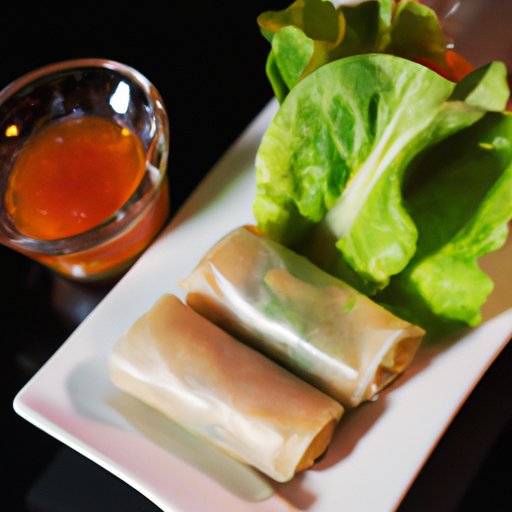I. Introduction
Spring rolls are a popular dish in many countries around the world, and for good reason! They are delicious, colorful, and versatile, making them an excellent option for any occasion. In this article, we will explore how to make classic spring rolls, as well as vegetarian and gluten-free options, the history and cultural significance of this dish, large spring rolls as a main dish and pairing spring rolls with refreshing drinks.
II. Classic Spring Rolls
For those who love the traditional recipe, making classic spring rolls is easy and fun! Although there are many variations out there, the classic recipe is based on a simple combination of vegetables, meat, and rice noodles wrapped in rice paper. Follow these steps for a delicious result:
- Prepare the filling: mix together cabbage, carrot, bean sprouts, and chopped shrimp or pork. Add salt, pepper, and sesame oil to taste.
- Soak the rice paper in warm water until it softens, then place it on a flat surface.
- Place the filling on one edge of the rice paper, then roll it up tightly, tucking the sides in as you go.
- Deep fry the spring rolls in vegetable oil for 3-4 minutes or until golden brown. Serve immediately with a dipping sauce of your choice.
Some tips for the perfect spring rolls include using fresh, crisp vegetables and making sure to wrap them tightly. For an added crunch, try adding rice noodles or chopped peanuts to the filling.
III. Gluten-free and Vegetarian Spring Rolls
For those with dietary restrictions, gluten-free and vegetarian spring rolls are a great option! Not only are they healthy and accessible, but they also offer a great opportunity to experiment with new ingredients and flavors.
A vegetarian recipe could include colorful vegetables and tofu, while a gluten-free recipe could include rice noodles and gluten-free soy sauce. Here’s a simple and delicious recipe:
- Prepare the filling: mix together mint, cilantro, carrot, cucumber, peppers, and tofu. Add salt, pepper, and gluten-free soy sauce to taste.
- Soak the rice paper in warm water until it softens, then place it on a flat surface.
- Place the filling on one edge of the rice paper, then roll it up tightly, tucking the sides in as you go.
- Serve the rolls fresh with a dipping sauce of your choice, such as sweet chili or peanut sauce.
For an added crunch, try adding chopped nuts or fried shallots to the filling. Experiment with different herbs and spices to create a unique flavor profile.
IV. The History and Cultural Significance of Spring Rolls
Spring rolls have a long and fascinating history in popular Asian countries. While their true origins are not known for certain, it is believed that they were first created as a way to use up leftover ingredients and rice paper.
Over time, spring rolls became a popular snack and part of many traditions and festivals. In the Vietnamese culture, spring rolls are served during Tet, the Vietnamese New Year, as a symbol of luck and prosperity. Similarly, in the Chinese culture, spring rolls are often served during the Spring Festival as a symbol of new beginnings and good luck.
While there are many variations of spring rolls across regions, the most popular type is still the classic recipe mentioned above. Variations include fresh (unfried) spring rolls, summer rolls, and egg rolls.
V. Large Spring Rolls as a Main Dish
If you’re looking for a creative and filling main dish, why not try making large spring rolls? Not only are they easy to share, but they also offer a fun and unique twist on the traditional recipe by incorporating more ingredients and flavors.
A great filling could include ground pork, shrimp, mushrooms, glass noodles, and bean sprouts. Here’s how to make them:
- Prepare the filling by sautéing the pork, shrimp, mushrooms, and bean sprouts until cooked through. Add garlic, ginger, soy sauce, and noodles to the mixture.
- Soak the rice paper in warm water until it softens, then place it on a flat surface.
- Place the filling on one edge of the rice paper, then roll it up tightly, tucking the sides in as you go. Make sure to make it bigger than a typical spring roll.
- Deep fry the spring rolls in vegetable oil for 5-6 minutes or until golden brown.
- Serve the rolls as a main dish, garnished with fresh herbs and a dipping sauce of your choice.
For a vegetarian option, try filling the large spring rolls with roasted vegetables and quinoa or tofu.
VI. Pairing Spring Rolls with Refreshing Drinks
No meal is complete without a refreshing beverage to wash it down! When it comes to pairing spring rolls with drinks, the possibilities are endless. Here are some suggestions to get you started:
- Classic spring rolls: pair with a light lager or an Asian-style ale for a cool and refreshing taste.
- Vegetarian spring rolls: pair with a chilled rosé or a fruity white wine to complement the fresh flavors of the vegetables.
- Larger spring rolls: pair with a rich red wine or a robust beer to balance out the heavier meat and noodle filling.
For non-alcoholic options, try pairing classic spring rolls with a Thai iced tea or a refreshing iced tea with mint and lemongrass. Vegetarian spring rolls pair well with a fruity mocktail or a sparkling water infused with fresh fruit.
VII. Conclusion
In conclusion, spring rolls are a delicious and versatile dish that can be enjoyed on many occasions. Whether you prefer the classic recipe or want to try something new with larger spring rolls, there’s something for everyone. And for those with dietary restrictions, vegetarian and gluten-free options allow for even more variety and experimentation.
By learning how to make spring rolls and experimenting with different recipes and fillings, you can create a unique dish that everyone will love.
